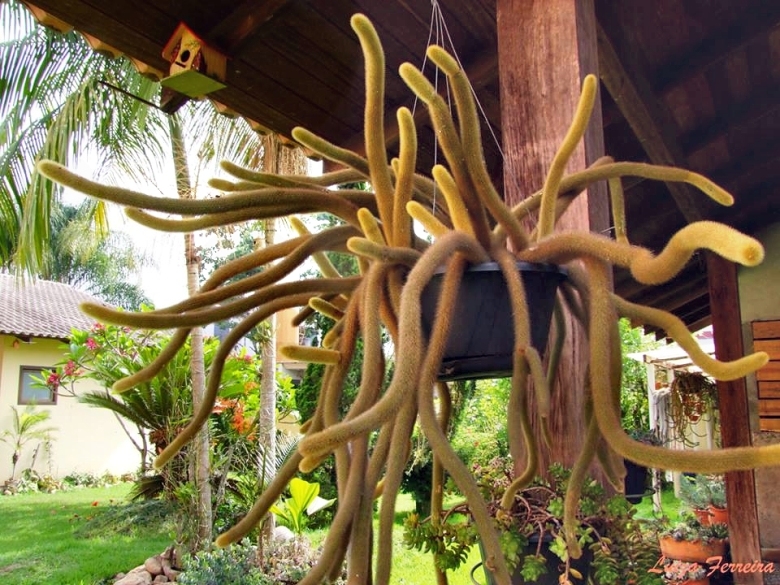Accepted Scientific Name: Cleistocactus winteri D.R.Hunt
Bradleya 6: 100. 1988

Loxanthocereus aureispinus (Cleistocactus winteri) Photo by: Luiza Ferreira
Origin and Habitat: This species is endemic to Bolivia, where it occurs in the province of Florida . It has a very restricted range (extent of occurrence is 250 km2) and is known from two isolated locations and collection is a major threat for this species. The northern subpopulation is known from a single cliff, whereas the southern subpopulation occurs over a stretch of approximately 10 km of cliffs.
Altitude range: Cleistocactus winteriSN|3784]]SN|3784]] grows at elevations of 1,300 to 1,400 metres above sea level.
Habitat and Ecology: The species occurs on cliffs within forests, in seasonally dry inter-Andean valleys. The southern subpopulation is negatively affected by local collectors, who use them as ornamental plants.
Synonyms:
See all synonyms of Cleistocactus winteri
Common Names include:
ENGLISH: Golden Rat Tail
ITALIAN (Italiano): Coda di scimmia
SPANISH (Español): Cola de rata, Cola de rata dorada, Cola de ratón, Cactus cola de rata dorado
SWEDISH (Svenska): Bronskaktus
Description: Cleistocactus winteriSN|3784]]SN|3784]], often labelled Hildewintera aureispinaSN|3782]]SN|3782]], is a branching columnar cactus of fairly rapid growth that resembles a very robust version of the popular peanut cactus (Lobivia chamaecereus). It forms soon tangled scrubs of long golden coloured drooping stems and produces vivid orange to salmon-pink flowers. They are repetitively and freely produced on mature plants from spring till frost and can last for several days.
Stems: Cylindrical, spreading, arching, pendant, or trailing that can grow up to 1,5 metres long and 2.5-6 cm wide with many branches.
Ribs: 16-17.
Areoles: Brown closely set.
Spines: About 50 bristly, flexible, straight, golden-yellow to brownish that literally cover the surface of the stems. The 20 or more, powerful central spines are 5 to 10 mm long. The 30 radiating spines are 4 to 10 mm long.
Flowers: Funnel-shaped, tubular, upturned vivid orange to salmon-pink, 4 to 6 cm in length, 5 cm across and very showy. Scale on the tube orange. Outer tepals radiating and bent back, inner ones shorter end upright. Stamens and style exerted.
Fruits: Barrel shaped, 7-10 mm long and wide, green to reddish-green.
Remarks: Hildewintera hybrids: Hildewimtera aureispina (now renamed Cleistocactus winteriSN|3784]]SN|3784]]i) is an old species that has been intensively hybridized with other cacti (especially Echinopsis and Lobivia sp. but also Matucana, Akersia, ecc) giving rise to some interesting intergeneric hybrid.
Hildewintera hybrid develops really amazing flowers of different colours on the original pendulous "hildewintera" body and many of these hybrids have cultivar names. This plants form soon spectacular clumps with several flowers at a time and are quite a sight. They are often thicker, stronger, larger growing than Hildewintera aureispinaSN|3782]]SN|3782]] and tend not to have the typical thin stemmed offsets. The offsets produced being more strongly attached to the main stems.
Bibliography: Major references and further lectures
1) James Cullen, Sabina G. Knees, H. Suzanne Cubey “The European Garden Flora Flowering Plants: A Manual for the Identification of Plants Cultivated in Europe, Both Out-of-Doors and Under Glass” Cambridge University Press, 11/Aug./2011
2) David Hunt, Nigel Taylor “The New Cactus Lexicon” DH Books, 2006
3) Edward F. Anderson “The Cactus Family” Timber Press, 2001
4) Urs Eggli, Leonard E. Newton “Etymological Dictionary of Succulent Plant Names” Springer, Berlin/Heidelberg 2010
5)Lowry, M. 2013. Cleistocactus winteri. The IUCN Red List of Threatened Species. Version 2014.3. <www.iucnredlist.org>. Downloaded on 08 April 2015.
6) Navarro, G. 1996. "Catálago ecológico preliminar de las cactáceas de Bolivia." Lazaroa 17: 33–84.
7) Nee, M. 2004. "Magnoliidae, Hamamelidae y Caryophyllidae." 2: 1–209. In M. Nee Fl. Reg. Parque Nac. Amboró Bolivia. Editorial FAN, Santa Cruz.
8) Véliz Pérez, M. E. 2008. "Cactáceas Guatemala" 1–129. Univ. de San Carlos de Guatemala, Guatemala.
Cultivation and Propagation: Cleistocactus winteriSN|3784]]SN|3784]] is of easy culture, which makes it a good cactus for beginners. It suited to hanging baskets as well as pots.
Soil: Use a loose well drained cactus mix.
Repotting: Since they are rapid growers need plenty of space for their roots, repotting with fresh potting-mix should be done every other year or when the plant has outgrown its pot. However, repotting doesn't necessarily mean they'll need larger containers.
Sun Exposure: Require filtered bright light, partial sun or light shade, but not in full sun that will sunscald it.
Watering: They require moderately watering through the growing season. This can be done weekly or more frequently during the summertime, if the weather is sunny enough, but allow to dry fully before watering again. Kept this way, plants will show a healthy growth. Keep rather dry as soon as the temperature starts dropping in October and keep it dry in winter. The plant survives outside without protection in winter (cold hardy to -2° ) but is then somewhat prone to rot, too.
Fertilization: Give an occasional high potassium liquid feed during the active growing period.
Hardiness: Winter care presents no problems at temperatures from 5 to 15 degrees centigrade with plenty of light, but frost hardy to -2°C for short periods if very dry. This plant needs a period of cool rest in winter to produce flowers abundantly. It flowers freely indoors too if conditions suit it.
Pest and diseases: They are generally fairly easy to grow, especially if kept pest-free. They are susceptible to, scale insects and spider mite. Watch carefully for infestations of stem and root mealy bugs, and damage from these may well initiate fungal attack.
Propagation: Easy to propagate from cuttings or seeds. Take cuttings spring or summer, let them dry till the ends callous well. Then replant them in fresh cactus soil that is ever so slightly moist, and keep it that way till they root. Surface sowing is the best; seeds germinate in 14-28 days at 20° C, remembering that seedlings dislike strong light and dry conditions.











